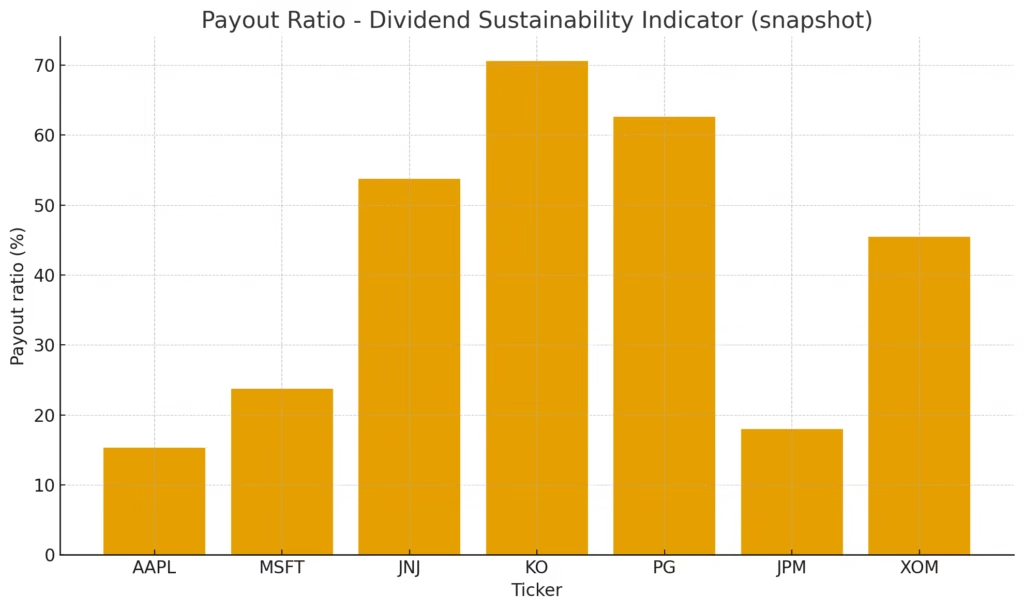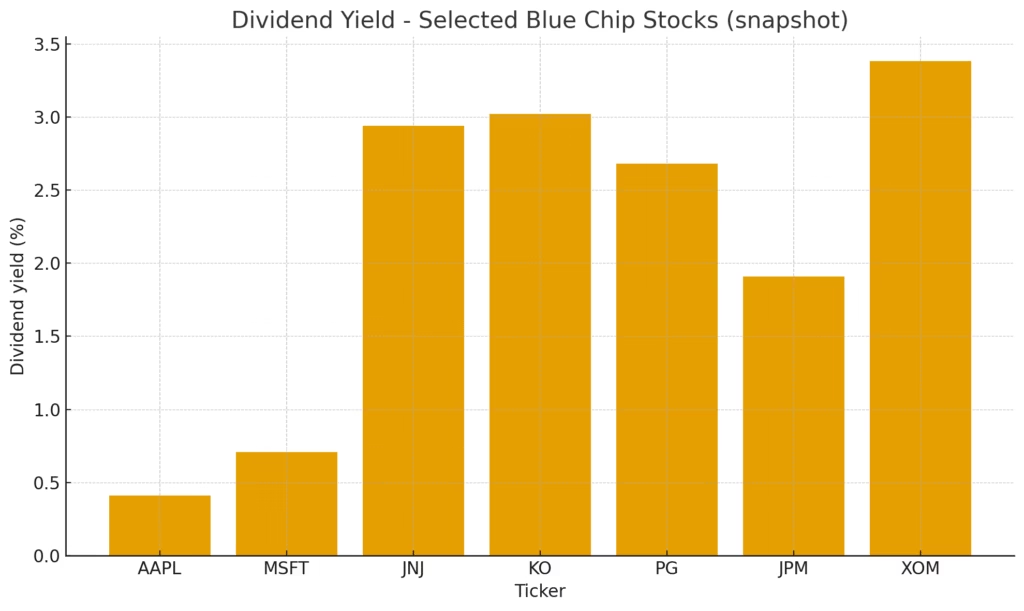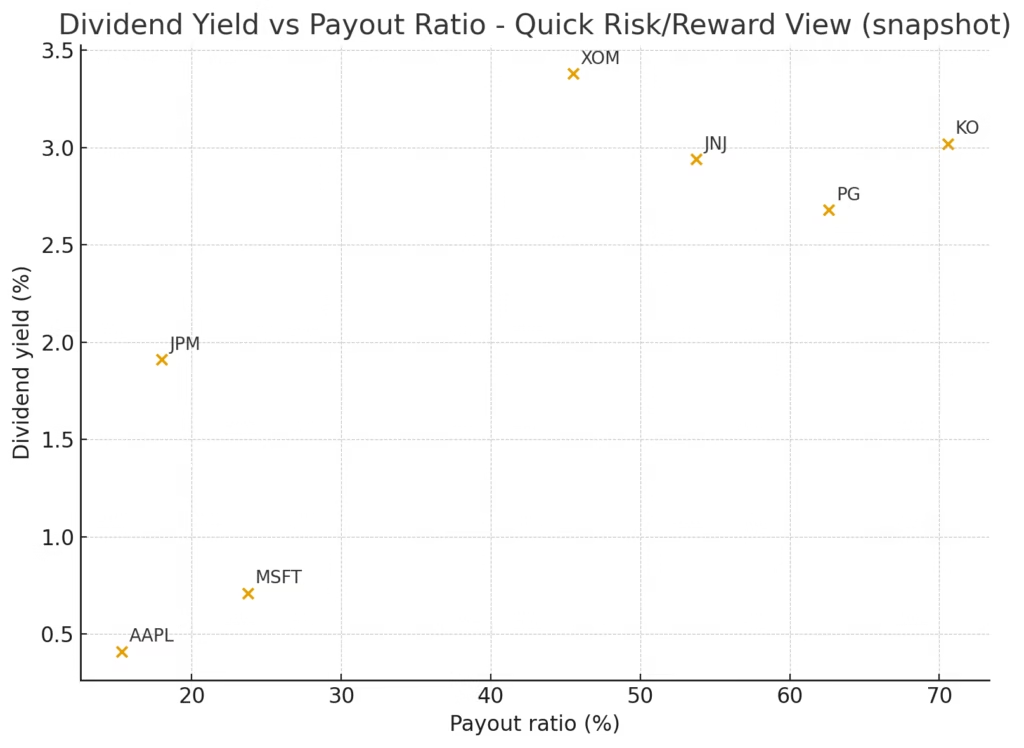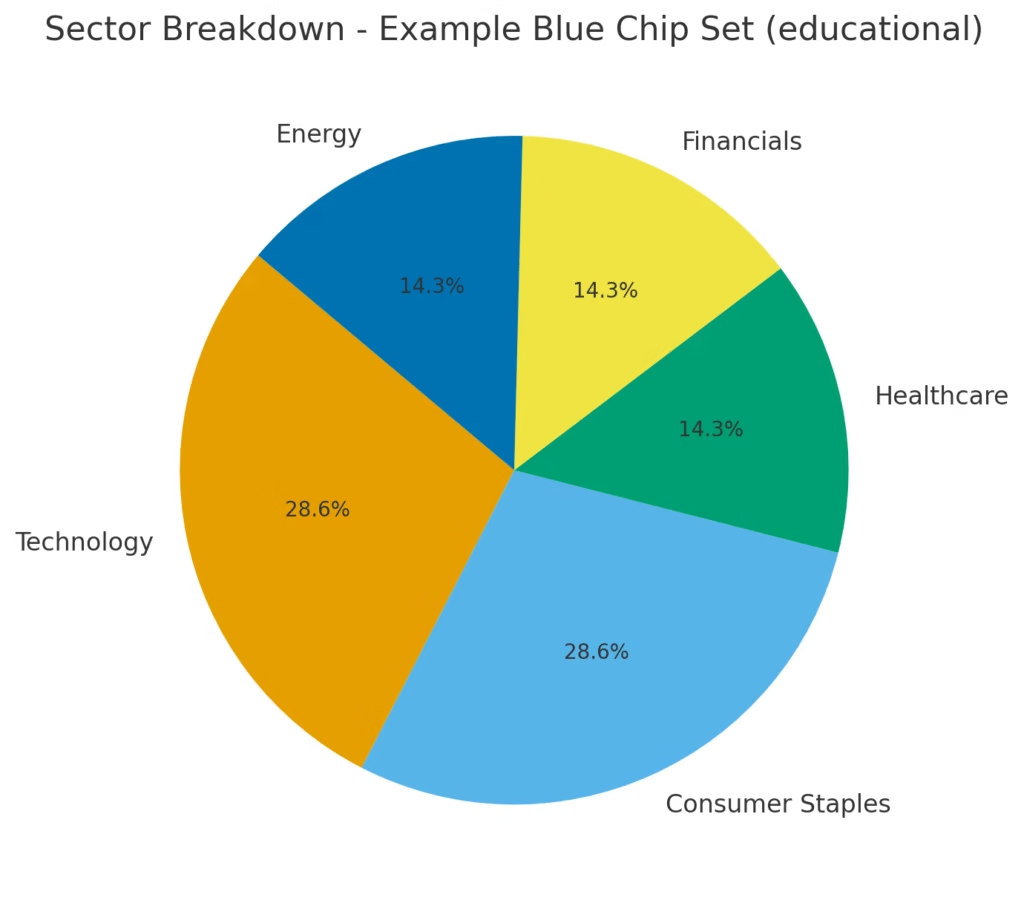
Imagine this. You are just starting your investing journey and the stock market feels like a giant maze of choices. Everywhere you look there are flashy growth stories, new IPOs, and hot stock tips from friends or social media. But deep down, you do not want wild bets. You want something solid. Something you can rely on for years without checking your phone every five minutes. That is why many beginners turn to the best blue chip stocks for beginners, stable companies with a proven track record of growth and reliability.
Blue chip stocks are the companies your parents probably recognize, the ones that have been paying dividends through wars, recessions, and market crashes. They may not double overnight like some risky startups, but the best dividend paying blue chip stocks can quietly make you wealthier while letting you sleep peacefully at night.
In this guide, we will break down what makes a stock a blue chip, why beginners love them, and show blue chip stock examples that can form the backbone of your investment portfolio for 2025 and 2026. Along the way, you’ll find real-life examples, portfolio tips, and answers to the questions most new investors ask when exploring blue chip investing.
By the end, you will not just know the names of a few blue chip stocks. You will also understand how to use them as the foundation of a long-term wealth-building strategy. Let’s dive in.
What Are Blue Chip Stocks?
Think of blue chip stocks as the “household names” of the stock market. These are companies that have been around for decades, consistently delivering profits, paying dividends, and weathering financial storms. When you hear names like Apple, Microsoft, Johnson & Johnson, or Coca-Cola, you’re thinking of blue chip stock examples.
These companies are called “blue chip” after the highest value poker chip color. Just like the poker chip, they represent stability and trust in the financial world. Beginners love them because they are less volatile compared to smaller companies, yet still provide steady growth opportunities.
Why Should Beginners Choose Blue Chip Stocks?
If you’re new to investing, you probably have three big concerns:
- Will I lose money quickly?
- Can I get reliable income?
- Are these stocks safe for the long term?
Blue chip stocks answer all three concerns:
- They have strong financial foundations, meaning you’re less likely to see extreme swings.
- They often pay dividends, giving you cash flow in addition to share growth.
- They adapt and survive across decades, making them suitable for long-term wealth building.
Quick Question: If you had to choose between safety and high risk, which would you pick? Comment below. Most beginners say safety, and that’s exactly why blue chips shine!
The Power of Dividends in Blue Chip Stocks
Here’s where it gets even better. Many blue chip stocks are also dividend paying stocks. That means they not only grow in value but also pay you part of their earnings on a regular basis. For beginners, this is like getting paid while you learn the stock market.
Imagine owning shares of Coca-Cola. Every quarter, you receive dividend payments whether the stock price goes up or down. Reinvesting those dividends can accelerate your wealth over time.

According to Investopedia, reinvested dividends have historically accounted for nearly 40% of stock market returns. That’s a huge reason why the best dividend paying blue chip stocks are top picks for beginners.
Blue Chip Stock Examples You Already Know
Here are some well-known blue chip stock examples:
- Apple (AAPL): Tech giant, consistent growth, innovative ecosystem.
- Microsoft (MSFT): Cloud, software, AI leadership.
- Johnson & Johnson (JNJ): Healthcare stability, reliable dividends.
- Coca-Cola (KO): Iconic brand, strong dividend history.
- Procter & Gamble (PG): Consumer goods powerhouse with global reach.
These companies have survived wars, recessions, pandemics, and still remain strong. That’s why they’re often the best blue chip stocks for beginners.
A Beginner’s Perspective: What If You Invest $1,000?
Let’s make this real. Suppose you invest $1,000 in a dividend-paying blue chip like Procter & Gamble at the start of 2025. Even if the stock doesn’t skyrocket, you’ll receive dividends that can compound over time. Over 10 years, with reinvestment, that $1,000 can easily grow to $1,800 to $2,000, depending on market conditions.
Now compare that with a risky penny stock, where your $1,000 could vanish overnight. Which feels safer? That’s the blue chip advantage.
Best Dividend Paying Blue Chip Stocks
Now that we understand what makes blue chips valuable, let’s zoom in on the best dividend paying blue chip stocks that beginners can consider in 2025 and 2026. Remember, these aren’t speculative bets; these are some of companies with proven track records, trusted by global investors, and capable of giving both growth and income.

1. Apple (AAPL)
Apple is not just about iPhones. It has created a massive ecosystem of services, wearables, and software. While its dividend yield (around 0.5 to 0.6%) is modest, Apple makes up for it with capital appreciation. Beginners love it because you’re essentially investing in innovation plus stability.
- Dividend Yield: 0.5%
- Why It’s Beginner-Friendly: Strong global brand, huge cash reserves, steady growth.
- 2025 – 2026 Outlook: Expansion in AI and services will keep pushing revenues higher.
2. Microsoft (MSFT)
Microsoft has reinvented itself through Azure cloud services, AI integration, and enterprise dominance. It offers consistent dividends while also being one of the strongest growth engines in the blue chip category.
- Dividend Yield: 0.7 to 0.9%
- Why It’s Beginner-Friendly: Diversified business, recurring revenue model.
- 2025 – 2026 Outlook: AI tools like Copilot will push revenue higher.
Quiz: If you had to choose only one tech blue chip (Apple vs Microsoft), which would you pick? Comment below and share your reasoning!
3. Johnson & Johnson (JNJ)
Healthcare is always essential, regardless of market cycles. Johnson & Johnson has increased dividends for over 60 years, making it a Dividend King. Beginners benefit from steady income and lower volatility.
- Dividend Yield: 3.1%
- Why It’s Beginner-Friendly: Healthcare resilience, consistent dividend growth.
- 2025 – 2026 Outlook: Despite legal challenges, its pharma pipeline and global presence remain strong.
4. Procter & Gamble (PG)
Think of everyday essentials like soap, detergent, baby products. P&G dominates this space with globally trusted brands. That stability translates to reliable dividends and recession-proof performance.
- Dividend Yield: 2.5%
- Why It’s Beginner-Friendly: Defensive stock, less market-sensitive.
- 2025 – 2026 Outlook: Strong pricing power even in inflationary times.
5. Coca-Cola (KO)
This is one of the most famous dividend paying blue chip stocks in history. Coca-Cola has been paying dividends since 1920 and increasing them for decades. For beginners, it’s a textbook example of passive income investing.
- Dividend Yield: 3%
- Why It’s Beginner-Friendly: Global brand recognition, strong cash flow.
- 2025 – 2026 Outlook: Diversification into healthier drinks and coffee is boosting resilience.
6. JPMorgan Chase (JPM)
For those comfortable with banking exposure, JPMorgan is the safest bet. It consistently pays dividends, adapts to economic cycles, and leads the global financial sector.
- Dividend Yield: 2.7%
- Why It’s Beginner-Friendly: Strong balance sheet, global financial leader.
- 2025 – 2026 Outlook: Rising interest rates may boost profitability.
7. ExxonMobil (XOM)
Energy is another sector that beginners shouldn’t ignore. ExxonMobil is a classic blue chip with consistent dividends, even during oil price volatility. It’s a defensive play with a high yield.
- Dividend Yield: 3.5 to 4%
- Why It’s Beginner-Friendly: Energy demand is always present.
- 2025 – 2026 Outlook: Renewables and energy transition investments will support long-term stability.
Want to compare how these dividend blue chips stack up against growth opportunities? Read our full guide on growth stocks vs value stocks.

How Beginners Can Build a Blue Chip Stock Portfolio
Knowing the best blue chip stocks for beginners is one thing, but selecting the right mix for your portfolio is where real success begins. Here are practical steps:
Step 1: Define Your Investment Goals
Ask yourself:
- Are you looking for income through dividends?
- Or do you want long-term growth with some income?
If your goal is regular passive income, stocks like Johnson & Johnson, Procter & Gamble, and Coca-Cola fit better. For balanced growth and income, Microsoft, Apple, and JPMorgan make more sense.
Step 2: Diversify Across Sectors
Beginners often make the mistake of investing only in tech because it feels familiar. Instead, spread across:
- Technology (Apple, Microsoft)
- Healthcare (Johnson & Johnson)
- Consumer Staples (Procter & Gamble, Coca-Cola)
- Finance (JPMorgan)
- Energy (ExxonMobil)
This ensures you’re not overly exposed to one industry during downturns.

Step 3: Use Blue Chip Stock Examples to Learn
For example:
- If you had invested $1,000 in Coca-Cola 20 years ago, with dividends reinvested, it would be worth over $8,000 today.
- Similarly, Microsoft investors have seen consistent stock appreciation alongside dividend growth.
These examples show how blue chips reward patience.
Step 4: Reinvest Dividends
One of the simplest but most powerful strategies is dividend reinvestment. By automatically reinvesting dividends back into buying more shares, beginners compound wealth faster without extra effort.
FAQs
1. Are blue chip stocks safe for beginners?
Yes, while no stock is completely risk-free, blue chip stocks are considered some of the safest equity investments due to their stability and long history.
2. How much should I invest in blue chips?
Beginners can start small, even with fractional shares. A consistent monthly investment of $100–$500 can grow substantially over time.
3. Do all blue chips pay dividends?
Most do, but some like Alphabet (Google) and Amazon focus on reinvestment rather than dividends. Beginners who want income should prioritize dividend paying blue chip stocks.
4. Are blue chip stocks better than ETFs?
ETFs offer diversification instantly, but blue chips let you own specific companies directly. Many beginners use a mix of both.
Quick Quiz
If you had $5,000 today, would you prefer to invest in:
- A single dividend blue chip like Coca-Cola for stable income
- A tech giant like Microsoft for growth plus dividends
- A diversified ETF that holds multiple blue chips
Share your answer in the comments below. Your choice can tell a lot about your investing style.
Final Thoughts
Why Blue Chip Stocks Belong in Every Beginner’s Portfolio
Blue chips are not flashy get-rich-quick bets. They are steady performers that allow beginners to build wealth gradually, generate dividends, and sleep peacefully at night.
The best blue chip stocks for beginners in 2025 and 2026 include dividend kings like Johnson & Johnson and Coca-Cola, defensive plays like Procter & Gamble, and innovative giants like Apple and Microsoft.
When combined in a diversified portfolio, they give you the perfect balance of income and long-term growth.



